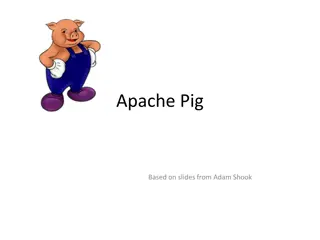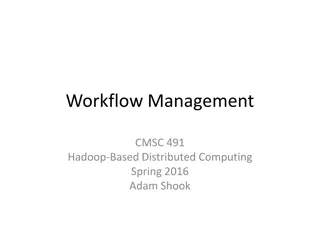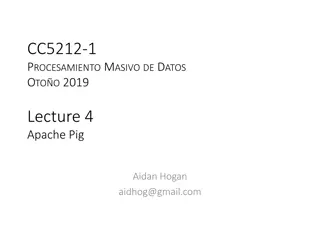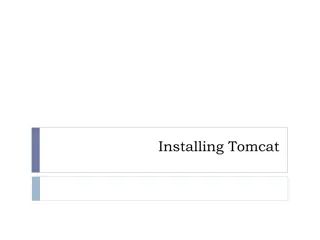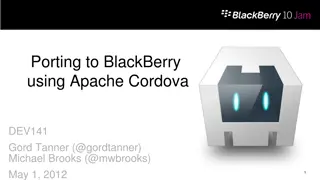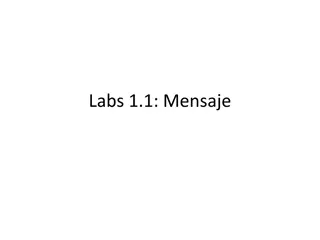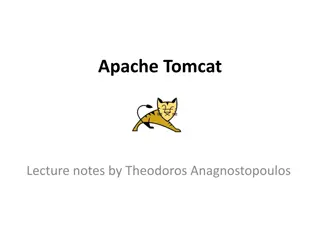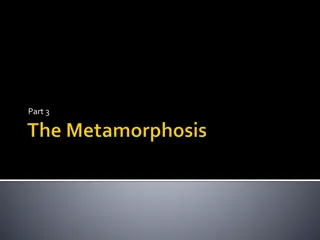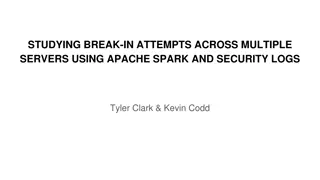Understanding Apache Kafka: A Messaging System Overview
Apache Kafka is a powerful software platform that facilitates data exchange between applications, servers, and processors through a distributed streaming process. Originally developed by LinkedIn and now maintained by Confluent under the Apache Software Foundation, Kafka serves as a robust message system that streamlines communication processes and offers a replacement for traditional message brokers. This article covers Apache Kafka's introduction, architecture, core components, use cases, and more, providing insights into its role as a reliable messaging system.
Download Presentation

Please find below an Image/Link to download the presentation.
The content on the website is provided AS IS for your information and personal use only. It may not be sold, licensed, or shared on other websites without obtaining consent from the author. Download presentation by click this link. If you encounter any issues during the download, it is possible that the publisher has removed the file from their server.
E N D
Presentation Transcript
Apache Kafka (Message Queue) with Code -By Praveen - By Praveen
Agenda Apache Kafka introduction Messaging system Apache Kafka as a Message system Apache Kafka Architecture Apache Kafka Work flow Apache kafka Core API Apache kafka Components Apache kafka Use cases RabbitMQ Vs Kafka Implementation Code - By Praveen
Apache Kafka introduction Apache Kafka is a software platform which is based on a distributed streaming process. It is a publish-subscribe messaging system which let exchanging of data between applications, servers, and processors as well. Apache Kafka was originally developed by LinkedIn in 2010, and later it was donated to the Apache Software Foundation. Currently, it is maintained by Confluent under Apache Software Foundation. In the year 2011 Kafka was made public. Kafka works well as a replacement for a more traditional message broker. Apache Kafka has resolved the lethargic trouble of data communication between a sender and a receiver. - By Praveen
Agenda Apache Kafka introduction Messaging system Apache Kafka as a Message system Apache Kafka Architecture Apache Kafka Work flow Apache kafka Core API Apache kafka Components Apache kafka Use cases RabbitMQ Vs Kafka Implementation Code - By Praveen
Messaging System There are two types of Messaging System: 1. Point to Point System 2. Publish-Subscribe System 1. Point to Point System Messages are persisted in a queue, but a particular message can be consumed by a maximum of one consumer only. Once a consumer reads a message in the queue, it disappears from that queue. The typical example of this system is an Order Processing System, where each order will be processed by one Order Processor, but Multiple Order Processors can work as well at the same time. The following diagram depicts the structure. - By Praveen
Messaging System 2. Publish-Subscribe System Messages are persisted in a topic. Unlike point-to-point system, consumers can subscribe to one or more topic and consume all the messages in that topic. In the Publish-Subscribe system, message producers are called publishers and message consumers are called subscribers. A real-life example is Dish TV, which publishes different channels like sports, movies, music, etc., and anyone can subscribe to their own set of channels and get them whenever their subscribed channels are available. - By Praveen
Apache Kafka as a Messaging System - By Praveen
Apache Kafka Architecture - By Praveen
Apache Kafka Architecture Cont... Kafka is a distributed, replicated commit log. Kafka does not have the concept of a queue which might seem strange at first, given that it is primary used as a messaging system. Queues have been synonymous with messaging systems for a long time. Let s break down distributed, replicated commit log a bit: Distributed because Kafka is deployed as a cluster of nodes, for both fault tolerance and scale Replicated because messages are usually replicated across multiple nodes (servers). Kafka is so powerful regarding throughput and scalability that it allow you to handle continuous stream of messages. Commit Log because messages are stored in partitioned, append only logs which are called Topics. This concept of a log is the principal killer feature of Kafka. - By Praveen
Apache Kafka Work Flow Following is the step wise workflow of the Pub-Sub Messaging Producers send message to a topic at regular intervals. Kafka broker stores all messages in the partitions configured for that particular topic. It ensures the messages are equally shared between partitions. If the producer sends two messages and there are two partitions, Kafka will store one message in the first partition and the second message in the second partition. Consumer subscribes to a specific topic. Once the consumer subscribes to a topic, Kafka will provide the current offset of the topic to the consumer and also saves the offset in the Zookeeper. Consumer will request the Kafka in a regular interval (like 100 Ms) for new messages. Once Kafka receives the messages from producers, it forwards these messages to the consumers. Consumer will receive the message and process it. Once the messages are processed, consumer will send an acknowledgement to the Kafka broker. Once Kafka receives an acknowledgement, it changes the offset to the new value and updates it in the Zookeeper. Since offsets are maintained in the Zookeeper. This above flow will repeat until the consumer stops the request. Consumer has the option to rewind/skip to the desired offset of a topic at any time and read all the subsequent messages - By Praveen
Apache Kafka Core API The Producer API allows an application to publish a stream of records to one or more Kafka topics. The Consumer API allows an application to subscribe to one or more topics and process the stream of records produced to them. The Streams API allows an application to act as a stream processor, consuming an input stream from one or more topics and producing an output stream to one or more output topics, effectively transforming the input streams to output streams. The Connector API allows building and running reusable producers or consumers that connect Kafka topics to existing applications or data systems. For example, a connector to a relational database might capture every change to a table. - By Praveen
What is Streams Think of s Stream as an infinite. Continuous real-time flow of data. data are a key-value pairs. In Kafka stream API transform and increases data. - Support per-record stream processing with milisecond. - By Praveen
Kafka Components Using the following components, Kafka achieves messaging: 1. Topic Basically, A Topic is a unique name for Kafka Stream. Topic is a category or feed name to which records are published, and stores messages. Topics in Kafka are always multi-subscriber; that is, a topic can have zero, one, or many consumers that subscribe to the data written to it. Each partition is an ordered, immutable sequence of records that is continually appended to a structured commit log. The records in the partitions are each assigned a sequential id number called the offset that uniquely identifies each record within the partition. - By Praveen
Kafka Components The Kafka cluster durably persists all published records whether or not they have been consumed using a configurable retention period. For example, if the retention policy is set to two days, then for the two days after a record is published, it is available for consumption, after which it will be discarded to free up space. Kafka's performance is effectively constant with respect to data size so storing data for a long time is not a problem. This is one of the biggest difference between RabbitMQ/ActiveMQ and Kafka. - By Praveen
Kafka Components 2. Kafka Producer It publishes messages to a Kafka topic.The producer is responsible for choosing which record to assign to which partition within the topic. 3. Kafka Consumer This component subscribes to a topic(s), reads and processes messages from the topic(s). 4. Kafka Broker Kafka Broker manages the storage of messages in the topic(s). If Kafka has more than one broker, that is what we call a Kafka cluster. 5. Kafka Zookeeper To offer the brokers with metadata about the processes running in the system and to facilitate health checking and managing and coordinating, Kafka uses Kafka zookeeper. - By Praveen
Kafka Components Partitions for the same topic are distributed across multiple brokers in the cluster. Partitions are replicated across multiple servers; number of replicas is a configurable parameter. Each Partition has one server as a leader and a number of servers as followers. Each Server acts a leader for some of its partitions and as a follower for some other. The Producers are responsible for choosing which message to assign to which partition within the topic based on key assigned to message. - By Praveen
Kafka Use Cases There are several use Cases of Kafka that show why we actually use Apache Kafka. Messaging For a more traditional message broker, Kafka works well as a replacement. We can say Kafka has better throughput, built-in partitioning, replication, and fault-tolerance which makes it a good solution for large-scale message processing applications. Metrics For operational monitoring data, Kafka finds the good application. It includes aggregating statistics from distributed applications to produce centralized feeds of operational data. Event Sourcing Since it supports very large stored log data, that means Kafka is an excellent backend for applications of event sourcing. - By Praveen
RabbitMQ Vs Kafka Let s see how they differ from one another: i. Features Apache Kafka Basically, Kafka is distributed. Also, with guaranteed durability and availability, the data is shared and replicated. RabbitMQ It offers relatively less support for these features. ii. Performance rate Apache Kafka Its performance rate is high to the tune of 100,000 messages/second. RabbitMQ Whereas, the performance rate of RabbitMQ is around 20,000 messages/second. iii. Processing Apache Kafka It allows reliable log distributed processing. Also, stream processing semantics built into the Kafka Streams. RabbitMQ Here, the consumer is just FIFO based, reading from the HEAD and processing 1 by 1. iv. Replay When your application needs access to stream history, delivered in partitioned order at least once. Kafka is a durable message store and clients can get a replay of the event stream on demand, as opposed to more traditional message brokers where once a message has been delivered, it is removed from the queue. - By Praveen
Implementation of Kafka Dependency uses: <dependency> </dependency> <groupId>org.springframework.kafka</groupId> <artifactId>spring-kafka</artifactId> - By Praveen
Implementation of Kafka Define the KafkaSender class to send message to the kafka topic named as developervisits-topic: import org.springframework.beans.factory.annotation.Autowired; import org.springframework.kafka.core.KafkaTemplate; import org.springframework.stereotype.Service; @Service public class KafkaSender { @Autowired private KafkaTemplate<String, String> kafkaTemplate; String kafkaTopic = "developervisits-topic"; public void send(String message) { kafkaTemplate.send(kafkaTopic, message); } } - By Praveen
Implementation of Kafka Define a Controller which will pass the message and trigger the send message to the Kafka Topic using the KafkaSender class. import org.springframework.beans.factory.annotation.Autowired; import org.springframework.web.bind.annotation.GetMapping; import org.springframework.web.bind.annotation.RequestMapping; import org.springframework.web.bind.annotation.RequestParam; import org.springframework.web.bind.annotation.RestController; import com.hcl.service.KafkaSender; @RestController @RequestMapping(value = "/developervisits-kafka/") public class ApacheKafkaWebController { @Autowired KafkaSender kafkaSender; @GetMapping(value = "/producer") public String producer(@RequestParam("message") String message) { kafkaSender.send(message); } return "Message sent to the Kafka Topic developervisits-topic Successfully"; } - By Praveen
Implementation of Kafka Finally Define the Spring Boot Class with @SpringBootApplication annotation import org.springframework.boot.SpringApplication; import org.springframework.boot.autoconfigure.SpringBootApplication; @SpringBootApplication public class SpringBootHelloWorldApplication { public static void main(String[] args) { } } SpringApplication.run(new Object[] { SpringBootHelloWorldApplication.class }, args); - By Praveen
Implementation of Kafka We are done with the required Java code. Now lets start Apache Kafka. As we had explained in detail in the Getting started with Apache Kafka perform the following. Download the Apache Kafka from this link: https://kafka.apache.org/downloads Start Apache Zookeeper- zookeeper-server-start.bat c:\shareData\development\appachekafka\kafka_2.12- 2.0.0\config\zookeeper.properties Start Apache Kafka- kafka-server-start.bat c:\shareData\development\appachekafka\kafka_2.12- 2.0.0\config\server.properties - By Praveen
Implementation of Kafka Next start the Spring Boot Application by running it as a Java Application. CREATE TOPIC ON KAFKA SERVER Also Start the consumer listening to the developervisits-topic kafka-topics.bat --create --zookeeper localhost:2181 --replication-factor 1 --partitions 1 --topic developervisits-topic PRODUCER kafka-console-producer.bat --broker-list localhost:9092 --topic developervisits-topic -OR- http://localhost:8080/developervisits-kafka/producer?message="test" CONSUMER kafka-console-consumer.bat --bootstrap-server localhost:9092 --topic developervisits-topic -- from-beginning - By Praveen
Questions - By Praveen










